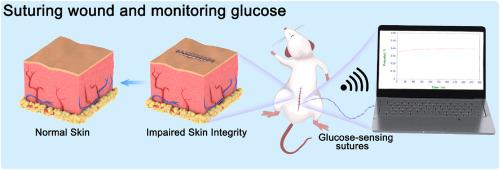用于伤口实时监测的电化学葡萄糖传感生物电子缝合线
IF 6
2区 化学
Q1 CHEMISTRY, ANALYTICAL
引用次数: 0
摘要
在临床实践中,伤口生理信息的实时原位监测对于帮助医疗保健专业人员评估患者伤口状态和愈合过程至关重要,血糖水平被认为是帮助医疗保健专业人员评估患者伤口状态的关键因素。平面柔性传感器的外形因素使其主要局限于皮肤表面和浅表伤口区域,而基于纤维的生物传感器由于其优异的柔韧性和机械强度,可以提供舒适的人机界面,因此具有实现皮肤深层伤口血糖水平实时监测的潜力。然而,它们仍然有相对单一的功能和需要外部电源的缺点。在这里,我们创新地提出了基于纤维生物燃料电池(Fiber BFC)的葡萄糖传感生物电子缝线,用于实时监测伤口部位的葡萄糖。BFC利用多孔镀金棉纤维(定义为“10-TAF”)作为基电极。纤维阳极以葡萄糖氧化酶(GOx)为催化剂,四硫代戊烯(TTF)为电子介质,对葡萄糖分子进行催化,纤维阴极以Pt NPs为催化剂,对O2进行还原。结果表明,BFC纤维具有良好的柔韧性和抗拉强度(断裂率为27%,杨氏模量为2795.41 MPa),力学性能与医用缝线相当,具有在多种复杂环境下稳定监测的能力。间歇运行128 h后,纤维BFC的Pmax仍保持在90.4%以上。通过缝合大鼠腹部伤口,结果表明纤维BFC具有优异的葡萄糖传感性能(灵敏度为9.25 mV mM-1)和生物相容性,可作为生物电子缝合线实时监测伤口,有望在临床应用中取代传统医用缝合线。本文章由计算机程序翻译,如有差异,请以英文原文为准。


Bioelectronic sutures with electrochemical glucose-sensing for real-time wound monitoring
Real-time in situ monitoring of wound physiologic information in clinical practice is essential to assist healthcare professionals in assessing the status of a patient's wound and the healing process, with glucose levels recognized as a key factor in assisting healthcare professionals in assessing the status of a patient's wound. The form factor of planar flexible sensors limits them primarily to the skin surface and superficial wound areas, while fiber-based biosensors, due to their excellent flexibility and mechanical strength, can provide comfortable human-machine interfaces and thus have the potential to realize real-time monitoring of blood glucose levels in deep wounds of the skin. However, they still have drawbacks of being relatively single-function and requiring external power sources. Here, we innovatively propose bioelectronic sutures with glucose-sensing based on Fiber Biofuel Cells (Fiber BFC) for real-time in situ monitoring of glucose at wound sites. Fiber BFC utilized porous gold-plated cotton fibers (defined as "10-TAF") as base electrodes. The fiber anode was assembled with glucose oxidase (GOx) as the catalyst, tetrathiafulvalene (TTF) as the electron mediator for the catalysis of glucose molecules, and the fiber cathode was assembled with Pt NPs as the catalyst for the reduction of O2. The results showed that Fiber BFC exhibited good flexibility and tensile strength (tensile deformation at break rate of 27 % and Young's modulus of 2795.41 MPa), with mechanical properties comparable to those of medical sutures, and possessed the ability to be steadily monitored in multifarious complex environments. In addition, the Pmax of Fiber BFC remained above 90.4 % after 128 h of intermittent operation. By suturing at abdominal wounds of rats, it was shown that Fiber BFC possesses excellent glucose sensing properties (sensitivity of 9.25 mV mM−1) and biocompatibility, and can be used as bioelectronic sutures for real-time monitoring of wounds, which is anticipated to replace traditional medical sutures in clinical applications.
求助全文
通过发布文献求助,成功后即可免费获取论文全文。
去求助
来源期刊

Analytica Chimica Acta
化学-分析化学
CiteScore
10.40
自引率
6.50%
发文量
1081
审稿时长
38 days
期刊介绍:
Analytica Chimica Acta has an open access mirror journal Analytica Chimica Acta: X, sharing the same aims and scope, editorial team, submission system and rigorous peer review.
Analytica Chimica Acta provides a forum for the rapid publication of original research, and critical, comprehensive reviews dealing with all aspects of fundamental and applied modern analytical chemistry. The journal welcomes the submission of research papers which report studies concerning the development of new and significant analytical methodologies. In determining the suitability of submitted articles for publication, particular scrutiny will be placed on the degree of novelty and impact of the research and the extent to which it adds to the existing body of knowledge in analytical chemistry.
 求助内容:
求助内容: 应助结果提醒方式:
应助结果提醒方式:


